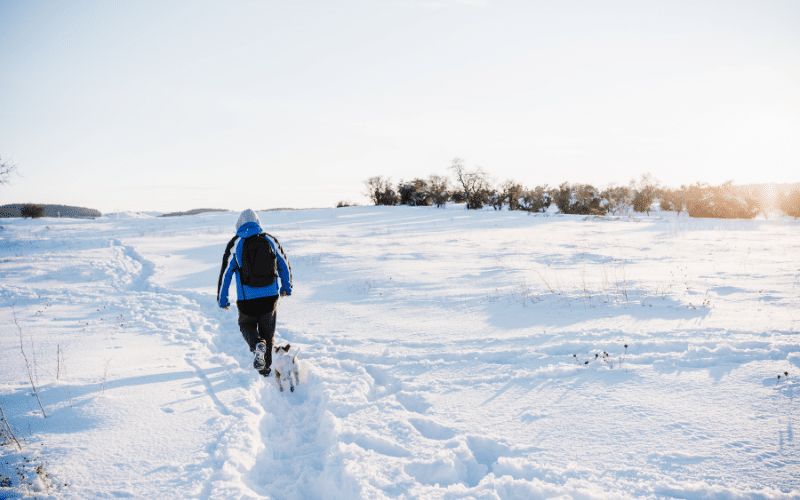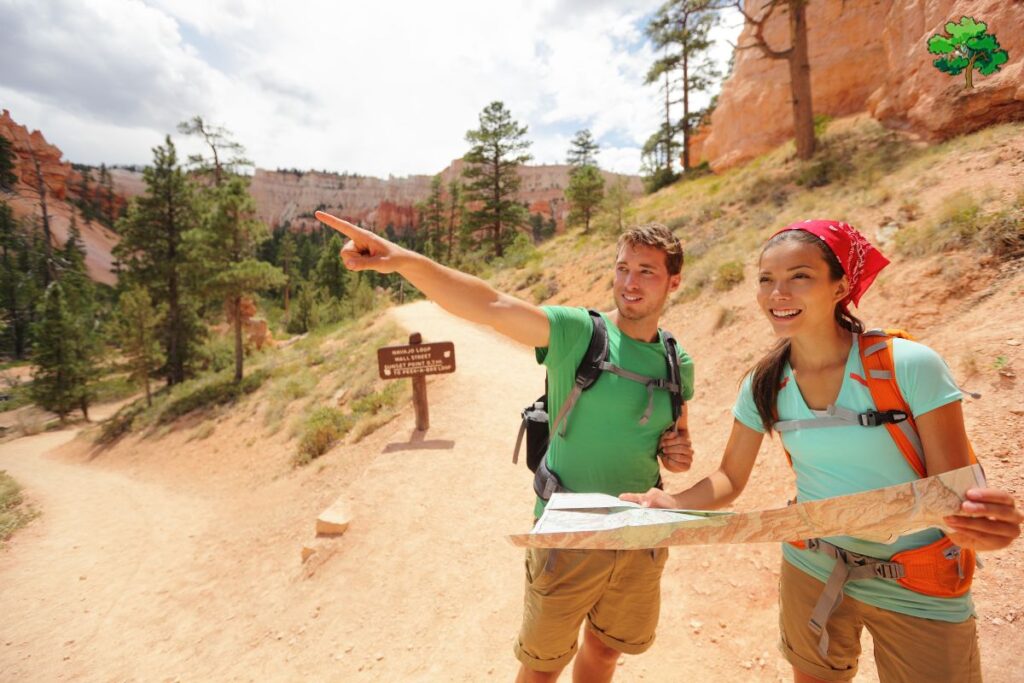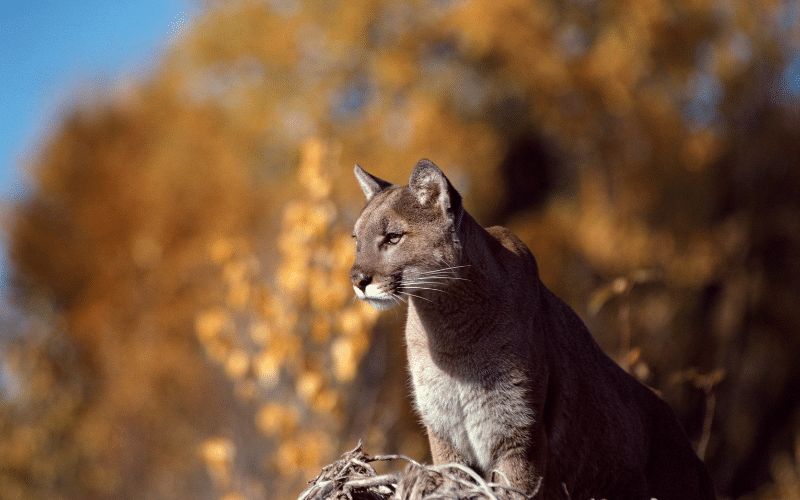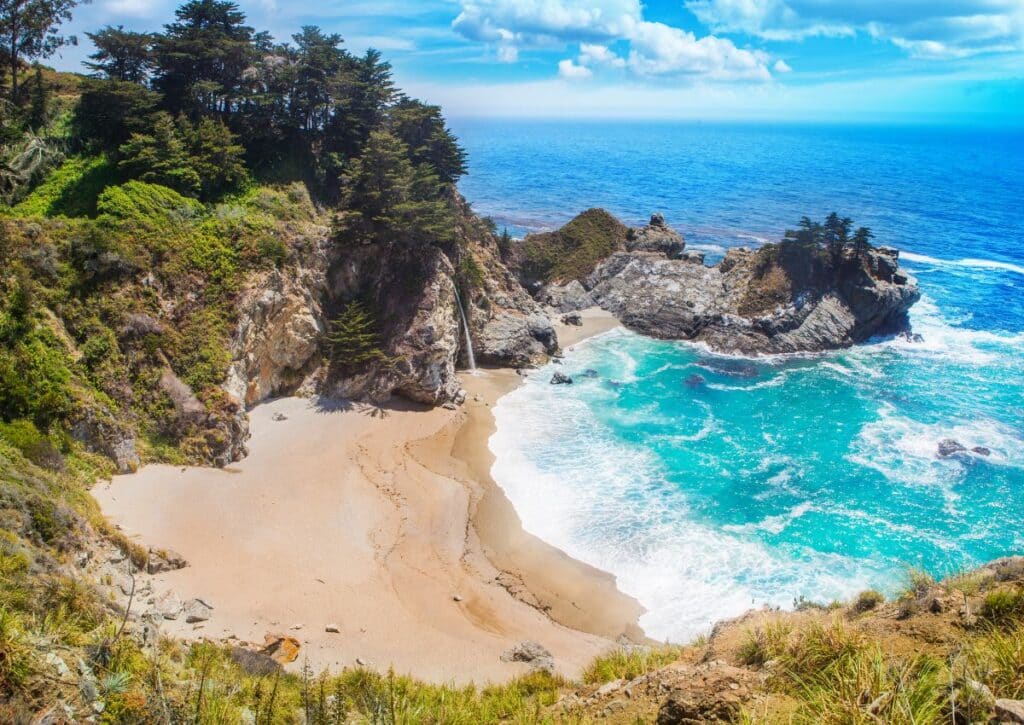Discover 17 top winter hikes around Bozeman, Montana! From tranquil trails to icy waterfalls, experience Big Sky Country's snowy paradise for hikers.
Get ready for a winter wonderland adventure with our guide to 17 sensational hikes around Bozeman, Montana!
Bozeman transforms into a snowy paradise, offering a haven for hikers eager to explore its tranquil trails and stunning scenery.
From the majestic Bridger Mountains to hidden icy waterfalls, each trail is a unique journey through a frost-kissed landscape.
Whether you’re in search of a serene stroll or a challenging trek, Bozeman has it all. Grab your boots, bundle up, and join us as we unveil the best winter hikes in Big Sky Country.
Let’s make those chilly days unforgettable with breathtaking vistas, crisp mountain air, and the joy of winter hiking!
Triple Tree Trail
Distance: 5.4 miles
Difficulty: Moderate
Starting Point: Triple Tree Trailhead
Distance from Bozeman: Approximately 6 miles to the south
Getting to the Trailhead: Head south on S. 19th Ave. from Bozeman for about 5 miles, then turn right onto Triple Tree Rd. Follow this road until you see the marked trailhead on your left.
The Triple Tree Trail, a local favorite, gets a magical transformation during the winter months.
As snow delicately covers the dense forests, this trail offers an enchanting hike filled with picturesque scenes and quiet moments of solitude.
The moderate difficulty ensures that the hike remains challenging enough without being too strenuous, making it suitable for those wanting to enjoy winter’s beauty without an extreme exertion.
The trail meanders through a variety of terrains including wooded areas, open meadows, and ridges. In winter, the meadows are blanketed in snow, offering opportunities for playful snowball fights or creating snow angels.
As you reach the higher points of the trail, you’ll be rewarded with panoramic views of the snow-covered Gallatin Valley, creating a postcard-perfect scene.
In winter, the Triple Tree Trail offers opportunities to spot some of Montana’s most resilient wildlife.
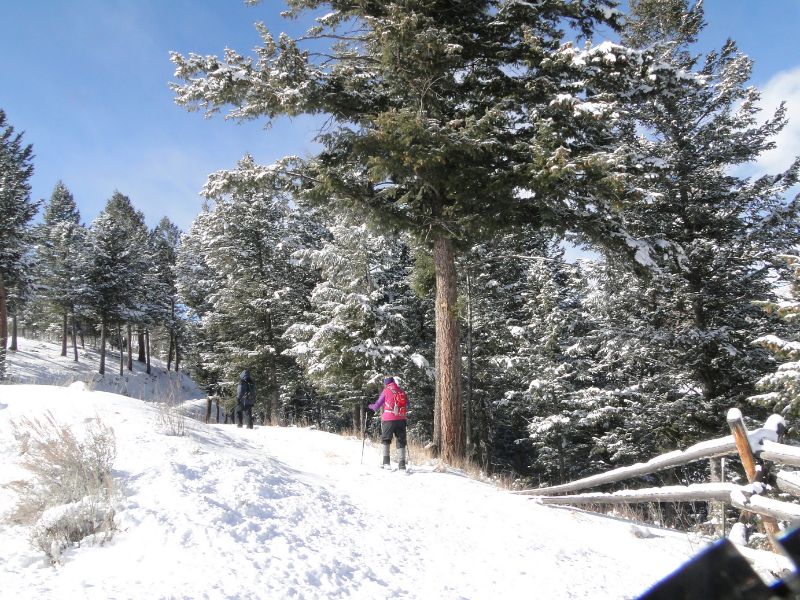
Look out for deer tracks in the snow, the occasional sighting of a snowshoe hare in its white winter coat, or even the majestic flight of a bald eagle against the backdrop of a clear blue winter sky.
While primarily a hiking trail, the blanket of snow often makes the Triple Tree Trail suitable for other activities like snowshoeing or winter bird watching. Its moderate distance means it’s feasible to complete a round trip in a single winter day.
Winter camping around Triple Tree Trail is limited and requires preparedness. The trail does not have designated camping spots, so it’s essential to check local regulations and ensure you’re set with cold-weather gear if planning an overnight stay.
It’s advisable for winter hikers to head back to Bozeman for accommodations or choose a recognized camping spot in the wider area.
The Triple Tree Trail offers a serene winter hiking experience, connecting you directly with Montana’s pristine beauty.
Whether you’re capturing photographs, spotting winter wildlife, or simply immersing yourself in the tranquil surroundings, this trail promises a memorable winter adventure.
Bridger Foothills Trail
Distance: Varies, up to 20 miles
Difficulty: Moderate to Strenuous
Starting Point: M Trailhead or several other access points along the Bridger Range
Distance from Bozeman: Approximately 5 miles to the northeast
Getting to the Trailhead: From Bozeman, head north on Rouse Ave which turns into Bridger Canyon Drive. Follow this for a few miles until you reach the marked trailhead for the M Trail. The Bridger Foothills Trail can be accessed from here and other points.
The Bridger Foothills Trail, stretching along the length of the scenic Bridger Range, offers a comprehensive experience of Montana’s winter wilderness.
Given its length and varied terrain, this trail provides hikers the freedom to choose sections suitable for their skill and stamina.
As you traverse this expansive trail, you’re greeted with a mix of dense forests, alpine meadows, and spectacular mountain vistas. Winter drapes the landscape in a pristine white cloak, making each view more mesmerizing than the last.
The higher elevations give you an eagle’s perspective of the Gallatin Valley and surrounding areas, covered in a shimmering blanket of snow.
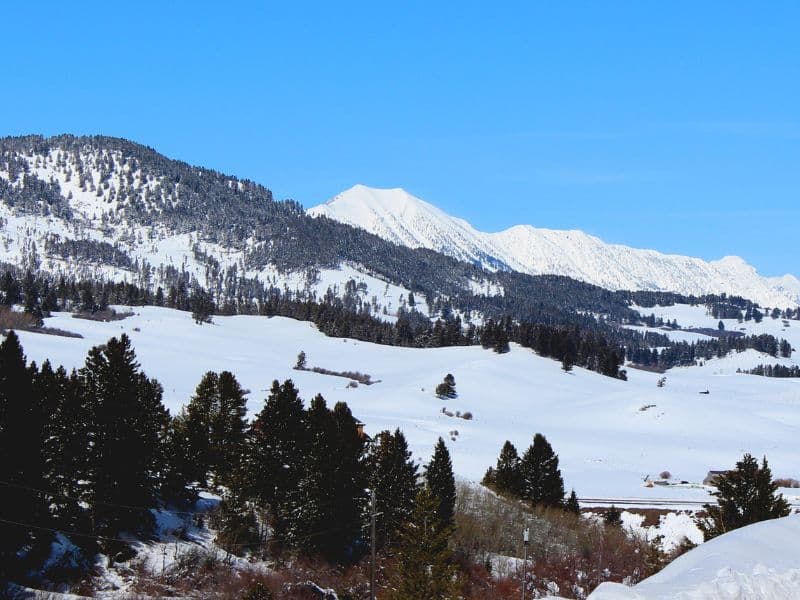
The vast expanse of the Bridger Foothills Trail makes it a hub for winter wildlife. Elk and deer often graze in the lower meadows, their dark silhouettes contrasting against the snow.
Tracks of snowshoe hares, foxes, and even bobcats might be spotted. Birdwatchers might get a glimpse of winter birds like the Clark’s nutcracker or the mountain chickadee.
While hiking is the main draw, the trail, with its extensive length and varying terrains, is also frequented by snowshoers and cross-country skiers.
Some sections, especially those at lower elevations, might be suitable for winter trail running for those seeking an adrenaline rush amidst the cold.
Several backcountry camping spots are sprinkled along the trail. However, winter camping in the Bridgers demands preparation and experience.
With night temperatures plunging and the possibility of snowstorms, it’s crucial to have appropriate gear and knowledge.
Always check the avalanche forecast and be equipped with avalanche safety equipment if considering an overnight stay.
The Bridger Foothills Trail is a testament to Montana’s rugged beauty and the spirit of adventure. Offering challenges and rewards in equal measure, this trail is a must-visit for every winter outdoor enthusiast.
Whether you’re on a brief snowy walk, a cross-country ski expedition, or a multi-day winter trek, the Bridger Foothills Trail promises memories that will last a lifetime.
Lava Lake Trail
Distance: 6 miles round trip
Difficulty: Moderate
Starting Point: Lava Lake Trailhead
Distance from Bozeman: Approximately 26 miles to the south via US-191
Getting to the Trailhead: From Bozeman, head south on US-191. After about 26 miles, look for the marked Lava Lake Trailhead parking area on your left.
In the Gallatin Canyon, the Lava Lake Trail offers an enticing winter escapade for those seeking both adventure and tranquility.
This moderately challenging trail winds through lush forests, along bubbling creeks, and ascends steadily until it unveils its crown jewel: the frozen Lava Lake.
From the very beginning, hikers are enveloped by thick evergreen forests, their branches laden with fresh snow.
The sound of Cascade Creek, often peeking through layers of ice, accompanies you as you tread the snowy path.
As you ascend, the trail offers sporadic views of the surrounding peaks, often dusted with a fresh layer of snow.
The culmination is the picturesque Lava Lake, frozen in winter’s grip. The lake, surrounded by towering peaks, reflects the sky and trees, creating a mesmerizing mirror effect.
The Lava Lake Trail is rich in wildlife, even during winter. Keep an eye out for the tracks of mountain goats, known to frequent the rocky outcrops around the lake.
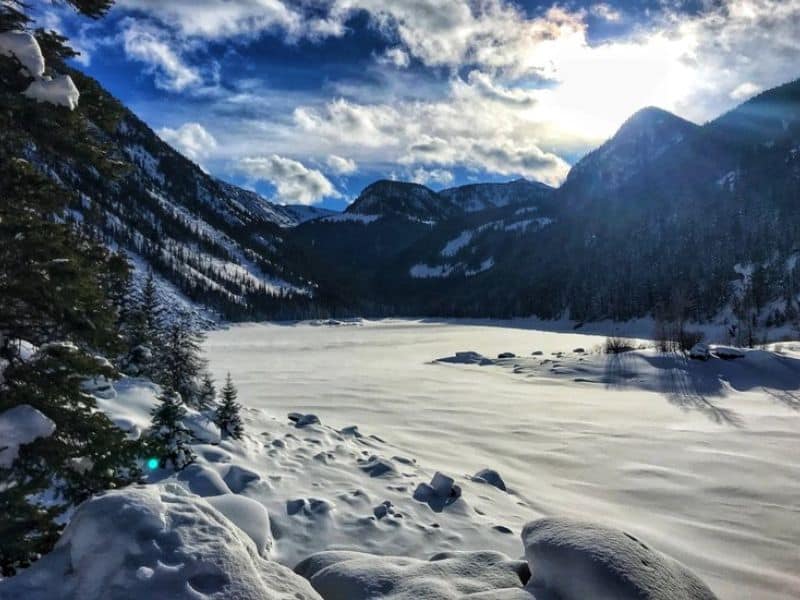
The dense forest is home to snowshoe hares, whose winter-white fur makes them almost invisible against the snowy backdrop.
Birds like the pine grosbeak or the gray jay might flit between the trees, adding a dash of life to the winter stillness.
Beyond traditional hiking, the snow-covered trail often lures snowshoers eager to witness the frozen beauty of Lava Lake.
Given the steady incline and well-trodden path, it’s a popular choice for those seeking a moderate snowshoeing challenge.
The lake itself, when sufficiently frozen, can be a unique spot for ice fishing enthusiasts, though safety precautions are paramount.
Winter camping near Lava Lake is an endeavor for the well-prepared. While there aren’t designated campgrounds directly along the trail, the surrounding Gallatin National Forest offers dispersed camping opportunities.
It’s crucial to be equipped for cold temperatures, and carrying avalanche safety gear is advised if considering an overnight adventure.
The Lava Lake Trail is more than just a path through the woods; it’s a journey through winter’s magical realm.
Whether you’re drawn by the allure of the frozen lake, the serenity of the snow-laden forests, or the potential wildlife encounters, this trail is a testament to nature’s winter artistry.
Every step taken on this trail brings a new appreciation for Montana’s winter wilderness, making it a must-visit during the colder months.
Hyalite Creek Trail to Hyalite Lake
Distance: 11 miles round trip
Difficulty: Moderate
Starting Point: Hyalite Creek Trailhead
Distance from Bozeman: Approximately 19 miles to the south via Hyalite Canyon Road
Getting to the Trailhead: From Bozeman, head south on S. 19th Ave which becomes Hyalite Canyon Road. Follow this scenic drive until you reach the well-marked Hy-alite Creek Trailhead.
Venturing deep into the heart of the Hy-alite Canyon, the Hy-alite Creek Trail unfolds like a winter epic.
Offering a blend of challenging terrains and nature’s frozen wonders, this trail beckons hikers with promises of majestic cascading waterfalls and a serene winter landscape unique to the canyon.
Right from the outset, the trail treats adventurers to the sights and sounds of Hyalite Creek, its waters dancing amidst snow and ice. As you progress, the undulating trail reveals a series of waterfalls, each more captivating than the last.
But the pièce de résistance is the Hyalite Falls, where water flows, splashes, and freezes, creating intricate ice sculptures against a backdrop of rugged rock faces.
The surrounding views of the snow-covered Hyalite Canyon, with its dense forests and lofty peaks, provide a serene setting that makes the hike truly rewarding.
The winter stillness of Hyalite Canyon offers glimpses of its resilient inhabitants. Look out for tracks or signs of moose, known to roam the dense forests and meadows.
The trail and its surroundings also host a variety of winter-active birds, like the mountain chickadee and the boisterous Stellar jay, which might add a splash of color and song to the winter silence.
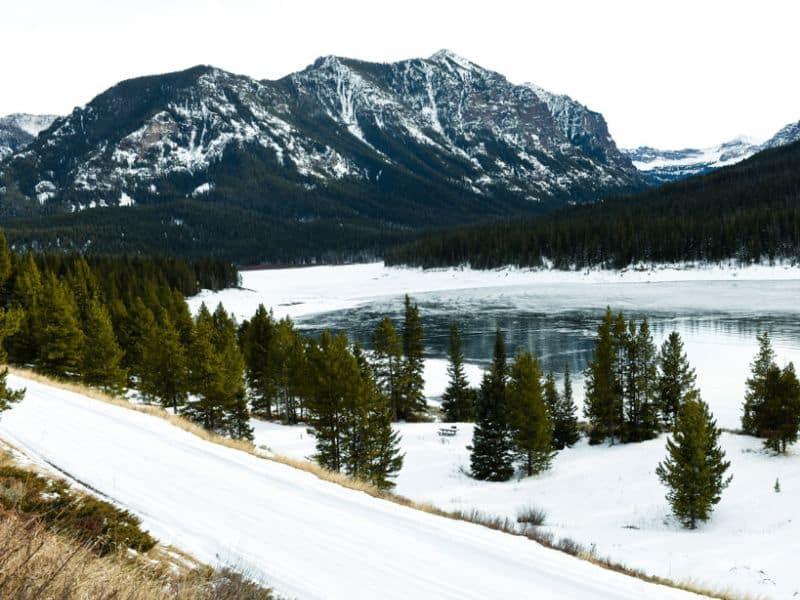
While the trail is a delight for hikers, its winter beauty also attracts snowshoers, especially after fresh snowfalls that blanket the path.
The series of cascading waterfalls, with their frozen forms, lure ice climbers seeking a unique challenge.
The towering ice columns and frozen drapery provide a surreal setting for this exhilarating winter sport.
Though the trail is doable in a day, some may want to prolong their canyon experience. There are several campgrounds in the Hyalite Canyon area, but winter campers should be adequately prepared for sub-zero temperatures and snow conditions.
Dispersed camping is allowed, but it’s essential to follow Leave No Trace principles and be aware of potential avalanche zones.
The Hyalite Creek Trail to Hyalite Falls is not just a path; it’s an experience. With its frozen cascades, serene canyon views, and the promise of solitude, it’s a winter wonderland waiting to be explored.
Whether you’re there for the hike, the climb, or simply to immerse in winter’s embrace, this trail stands as a testament to the enchanting beauty of Montana’s colder months.
Grotto Falls
Distance: 2.5 miles round trip
Difficulty: Easy
Starting Point: Grotto Falls Trailhead
Distance from Bozeman: Approximately 23 miles to the south via Hyalite Canyon Road
Getting to the Trailhead: From Bozeman, drive south on S. 19th Ave, which transitions into Hyalite Canyon Road. After traveling through the picturesque canyon, look for signs directing you to the Grotto Falls Trailhead.
For those in search of a quick winter escape with a grand finale, the Grotto Falls trail is a perfect pick. This easy hike is nestled within the scenic Hyalite Canyon and offers hikers an opportunity to witness one of Montana’s winter marvels: a frozen waterfall.
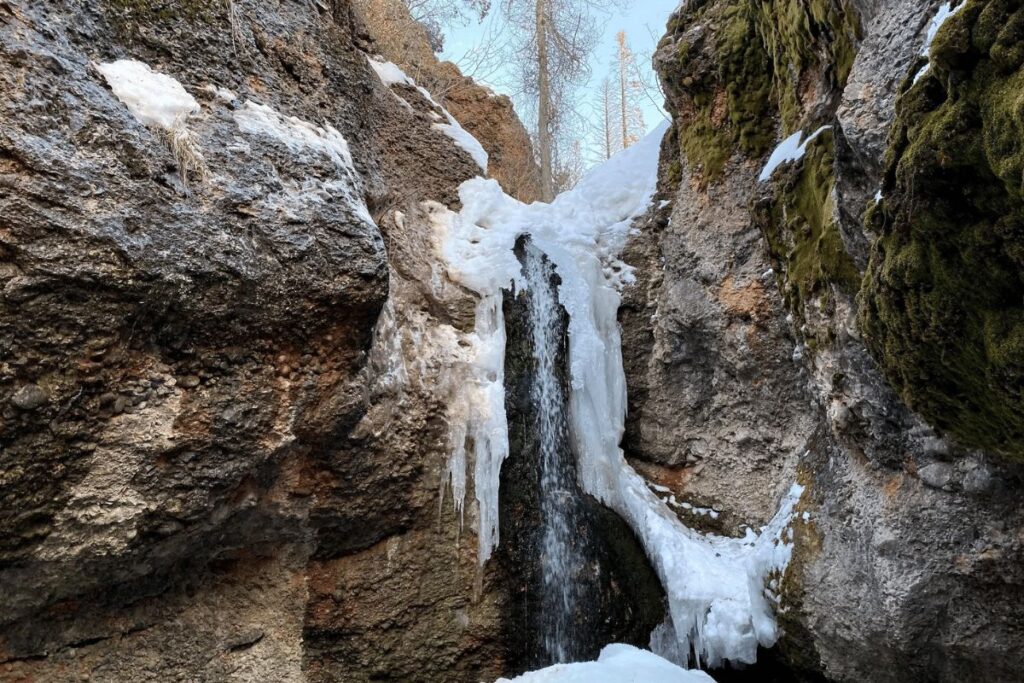
The trail blanketed in snow, meanders through a dense coniferous forest, with the melodious burbling of Hyalite Creek accompanying hikers.
It’s a serene walk, where every footstep is muffled by the soft snow beneath. The climax of this journey is the surreal Grotto Falls.
In winter, the cascading waters slow down, creating a frozen spectacle. Icicles hang like nature’s chandeliers, while the frozen waterfall glistens, reflecting the subtle hues of winter skies.
The tranquility of the trail and its surroundings make it a haven for wildlife. Keep an eye out for the intricate tracks of snowshoe hares or the occasional fox darting between trees.
Birds such as the nuthatch or the pine siskin might make an appearance, fluttering among the snow-laden branches.
Beyond hiking, the easy terrain of the Grotto Falls trail makes it popular among snowshoers, especially those just getting acquainted with the activity.
The frozen falls themselves attract photographers and nature enthusiasts, keen on capturing the delicate beauty of ice and snow juxtaposed against the rugged canyon backdrop.
Given the trail’s short length, most visitors opt for a day trip. However, for those wanting to extend their stay in Hyalite Canyon, there are campgrounds and dispersed camping options available nearby.
Winter campers should always be well-equipped and conscious of the cold, often harsh, conditions.
The Grotto Falls trail is a gentle reminder that nature’s grandeur isn’t always tucked away at the end of strenuous paths.
Sometimes, a short walk is all it takes to unveil a scene of captivating beauty. For families, couples, or solo hikers, this trail is a must-visit during Bozeman’s winter months, promising a blend of peace, beauty, and wonder.
Bozeman Creek Trail (Sourdough Canyon)
Distance: 10 miles round trip
Difficulty: Moderate
Starting Point: Sourdough Canyon Trailhead
Distance from Bozeman: Approximately 8 miles to the south
Getting to the Trailhead: From Bozeman, take S. Church Avenue, which merges into Sourdough Road. Follow it until reaching Nash Road and turn right. Shortly after, you’ll find signs for the Sourdough Canyon Trailhead.
The Bozeman Creek Trail, commonly referred to as the Sourdough Canyon Trail, presents a beautiful winter passage through Montana’s mesmerizing landscapes.
Tracing the route of the tranquil Bozeman Creek, this trail ensures a serene experience while embracing the white wonders of winter.
From the outset, hikers are graced with the calming ambiance of Bozeman Creek, its waters flowing gently amidst a snow-clad environment.
As you progress, the trail offers an alternating view of dense forest canopies and open meadows, all under the gentle touch of winter frost.
The gentle hum of the creek provides a rhythmic soundtrack, making each step feel harmonious with nature.
What’s more, the even terrain and well-marked path ensure a smooth journey, whether you’re on foot or skis.
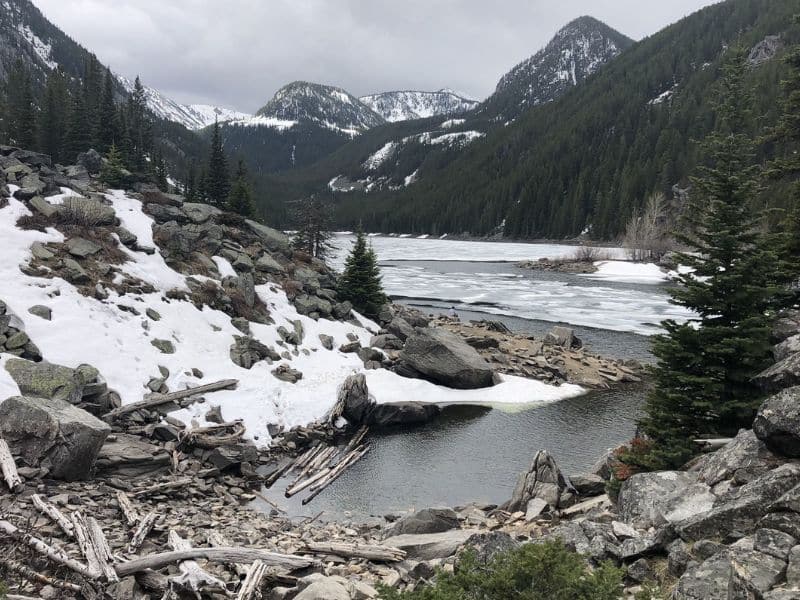
The diverse habitats along the Bozeman Creek Trail provide homes for various winter-active creatures.
Deer can often be seen grazing in the meadows, their coats contrasting starkly against the pure snow.
The playful chatter of squirrels and the occasional calls of winter birds such as the crossbill or grosbeak provide a lively soundscape for the trail.
Besides traditional hiking, the trail’s expansive and relatively flat terrain makes it a popular choice for cross-country skiing.
The parallel paths carved out by previous skiers offer a convenient track, making it suitable for both novice and experienced skiers.
Snowshoers too can enjoy the beauty of the trail, especially after a fresh snowfall blankets the path.
While many prefer the trail for day trips given its proximity to Bozeman, there are options for extended stays.
The nearby Gallatin National Forest offers opportunities for dispersed camping. However, winter campers should be well-prepared, bearing in mind the chilly nights and potential snow accumulation.
The Bozeman Creek Trail is more than just a pathway beside a creek; it’s a winter sanctuary close to the heart of Bozeman.
Providing an inviting route for hikers, skiers, and nature enthusiasts, this trail exemplifies the quiet, understated beauty of Montana’s winters.
Whether you’re seeking solitude, a family outing, or an active ski day, Sourdough Canyon promises a rejuvenating experience.
Bear Trap Canyon Trail
Distance: 7 miles round trip
Difficulty: Easy to Moderate
Starting Point: Bear Trap Canyon Trailhead
Distance from Bozeman: Approximately 32 miles to the northwest via Norris Rd and US-287 N
Getting to the Trailhead: From Bozeman, head west on W. Main Street. Continue onto Norris Rd and after a stretch, take a left onto US-287 N. Follow the signs directing you to Bear Trap Canyon Trailhead.
Winding alongside the mighty Madison River, the Bear Trap Canyon Trail offers a unique winter sojourn, marked by the juxtaposition of roaring river waters and the tranquillity of a snowy landscape.
Ideal for those seeking an immersive riverside experience, this trail combines natural beauty with an accessible terrain.
As you embark on this journey, the Madison River immediately captivates with its lively presence, with water rapids occasionally breaking the winter silence.
The trail meanders through a mix of open areas and patches of coniferous woods, each vantage point providing a fresh perspective of the river and the encompassing Bear Trap Canyon.
During winter, the snow-capped boulders and ice formations along the riverbanks add a touch of magic, making the landscape seem like a winter postcard come to life.
The river’s dynamic ecosystem attracts various fauna, even during the colder months. Eagles can often be seen soaring overhead, scouting for fish in the open river waters.
Mule deer might be spotted grazing in the snow-draped meadows, while otters occasionally play along the river’s icy edges.
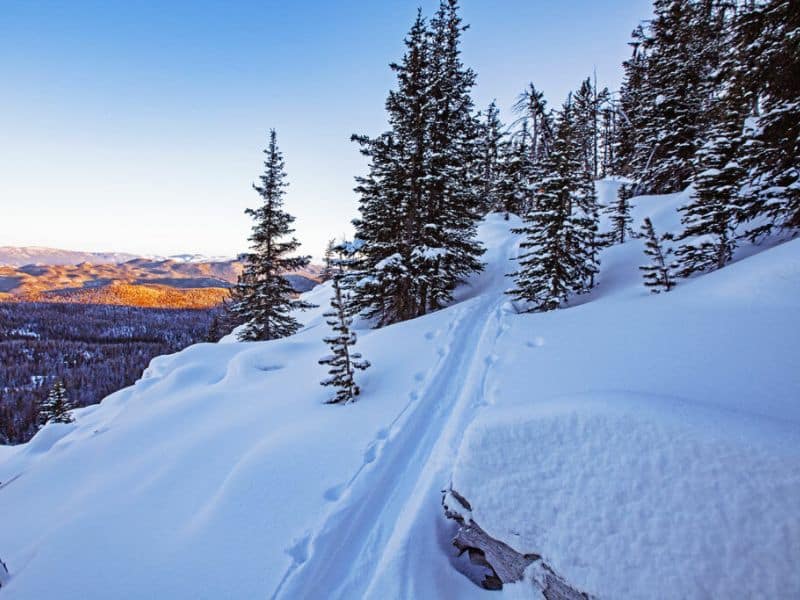
Apart from traditional hiking, the trail’s gentle inclines and serene environment make it a favorite among snowshoers.
Those interested in fishing might find certain sections of the Madison River teeming with activity, as winter can be a productive season for fly-fishing, especially in the slower-moving parts of the river.
While the Bear Trap Canyon Trail is commonly explored as a day hike, adventurous souls can find dispersed camping options in the encompassing area.
Remember, winter camping requires preparation and respect for the environment. Ensure you’re equipped to handle the cold and always adhere to Leave No Trace principles.
The Bear Trap Canyon Trail is a testament to nature’s ability to mesmerize, irrespective of the season.
Offering both solace and sensory delight, the trail is a call to those who find joy in the sounds of rushing waters and the sight of pristine winter landscapes.
Whether you’re an avid hiker, a budding naturalist, or someone seeking a peaceful retreat, this riverside trail is bound to leave an indelible mark on your heart.
Middle Cottonwood Trail
Distance: 4 miles round trip
Difficulty: Moderate
Starting Point: Middle Cottonwood Trailhead
Distance from Bozeman: Approximately 12 miles to the north via Springhill Rd and Sypes Canyon Rd
Getting to the Trailhead: From Bozeman, take N. 7th Avenue, transitioning onto Springhill Rd. A right turn onto Sypes Canyon Rd will lead you to the Middle Cottonwood Trailhead, signposted on the left.
Meandering through the rich tapestry of the Bridger Range, the Middle Cottonwood Trail offers hikers a winter wonderland experience.
With dense forests casting long shadows over the snow-blanketed path and serene stillness punctuated by the occasional forest sound, it’s a haven for those who appreciate the understated beauty of winter.
The trail begins with a gentle incline, guiding hikers deeper into the heart of the forest. As you progress, the tall pine and fir trees seem to envelope the path, their branches heavy with snow, creating natural archways.
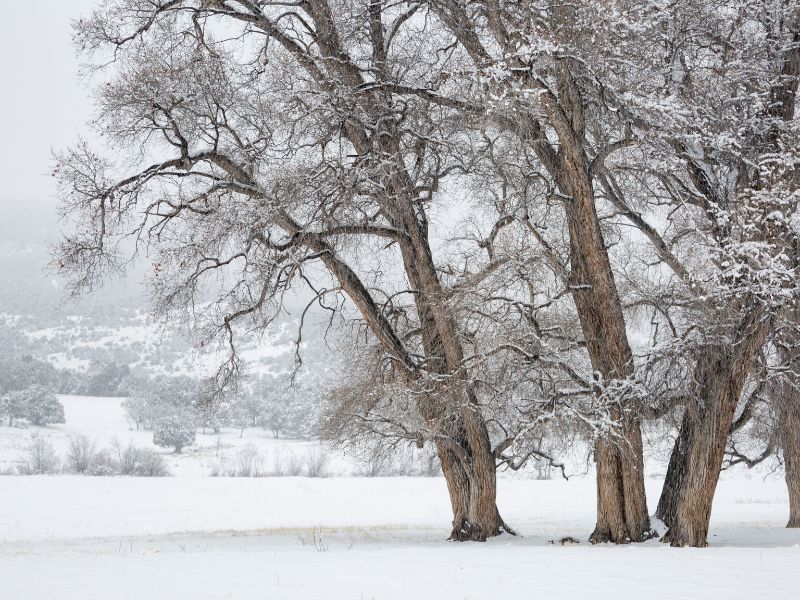
The sun filters through the canopy, reflecting off the pristine snow, casting a myriad of hues and shadows. Occasionally, clearings reveal panoramic vistas of the snow-covered Bridger Range and the valleys below, providing breathtaking contrast to the dense woodland interiors.
Winter’s hush does not mean the absence of life. The Middle Cottonwood Trail is frequented by the likes of snowshoe hares, whose white winter coats blend seamlessly with the snowy backdrop.
Tracks of mule deer or the elusive bobcat might be spotted, giving insights into the quiet dramas unfolding in the forest. Birdwatchers might be treated to sights of winter-active birds like the woodpecker or the hardy mountain bluebird.
While hiking is a popular activity, the trail’s snow-covered terrain also beckons snowshoers, especially after fresh snowfalls. The dense forests and occasional clearings also make it a picturesque spot for winter photography, capturing the raw, untouched beauty of the season.
Given the trail’s moderate length and proximity to Bozeman, many prefer it as a day hike. However, for those keen on an overnight experience, there are dispersed camping opportunities in the adjacent areas.
As always, winter camping demands proper equipment and a respect for nature to ensure safety and minimal environmental impact.
The Middle Cottonwood Trail is a tribute to the silent, awe-inspiring allure of winter. With every step, hikers are invited to immerse themselves deeper into a world where nature’s grandeur is painted in shades of white and green.
It’s a trail not just for the feet but also for the soul, promising solace, beauty, and a deeper connection with the wilderness.
Kirk Hill Trail
Distance: 2 miles round trip
Difficulty: Easy
Starting Point: Kirk Hill Trailhead
Distance from Bozeman: Just about 6 miles to the south via S. 19th Ave
Getting to the Trailhead: Departing from Bozeman, drive south on S. 19th Ave. A few miles down the road, look for signs indicating the Kirk Hill Trailhead.
Situated a stone’s throw from Bozeman, the Kirk Hill Trail is the perfect escapade for families and individuals alike seeking a quick dose of nature and panoramic vistas.
Its short distance and manageable terrain make it an ideal winter hike, especially for those looking for a less strenuous outing.
Embarking on the trail, hikers are immediately treated to the embrace of a gentle woodland, with snow-covered trees lining the path. As you ascend the modest elevation, the trail unveils increasingly impressive vantage points.
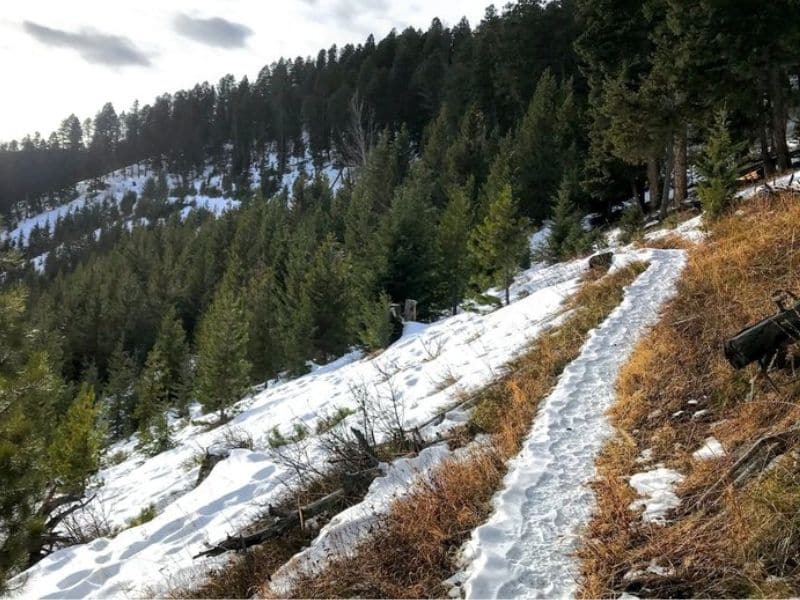
At its pinnacle, hikers are rewarded with delightful views of Bozeman set against the vast winter landscape – a blend of urban and natural that’s sure to captivate.
While it’s a brief journey, nature enthusiasts might spot signs of the local fauna.
Tracks of deer or squirrels might be evident in the snow, and the keen-eyed observer might catch a glimpse of winter birds flitting between the trees, adding a dash of color and song to the stark beauty of the season.
Beyond the traditional hiking experience, the Kirk Hill Trail’s accessibility makes it popular for snowshoeing.
Its proximity to Bozeman also means it’s frequented by those looking for a short, rejuvenating outdoor exercise session, be it a brisk walk or a casual snowball fight.
Given the trail’s concise nature and closeness to Bozeman, it’s predominantly a day-trip destination.
However, those wishing to extend their outdoor adventure have numerous camping opportunities in the larger areas surrounding Bozeman, albeit a short drive away.
The Kirk Hill Trail is a testament to the beauty that lies right at Bozeman’s doorstep. It’s a reminder that one doesn’t always need to journey far to find a scenic retreat.
Whether it’s a family outing, a solo introspective walk, or a simple need to stretch one’s legs amidst nature, Kirk Hill promises a refreshing and delightful experience.
Baldy Peak
Distance: 6.7 miles round trip
Difficulty: Strenuous
Starting Point: M Trailhead
Distance from Bozeman: Roughly 3 miles to the northeast via Bridger Dr
Getting to the Trailhead: From Bozeman, head north on Rouse Ave, which becomes Bridger Dr. A short drive will lead you to the prominent M Trailhead, marking the commencement of your journey to Baldy Peak.
The ascent to Baldy Peak is no ordinary trek; it’s an adventure, a challenge, and a reward all in one. As the highest peak in the Bridger Range, it beckons the adventurous spirit, promising unparalleled panoramas and a sense of accomplishment that lingers long after the descent.
The journey begins with the famous ‘M’ trail, named for the large stone “M” placed by Montana State University students. As hikers continue past this initial landmark, the climb becomes increasingly demanding.
The terrain transitions from dense forests to exposed ridgelines, and winter adds its own layer of challenge, cloaking the path in snow and ice.
The ascent requires determination, but the summit’s panoramic views are unparalleled, offering a breathtaking sweep of the Gallatin Valley, Bozeman, and a horizon dotted with mountain ranges.
The diverse terrains leading to Baldy Peak host an array of wildlife. While winter may reduce visible activity, it’s not uncommon to see traces of mountain goats, known to navigate these high altitudes effortlessly.
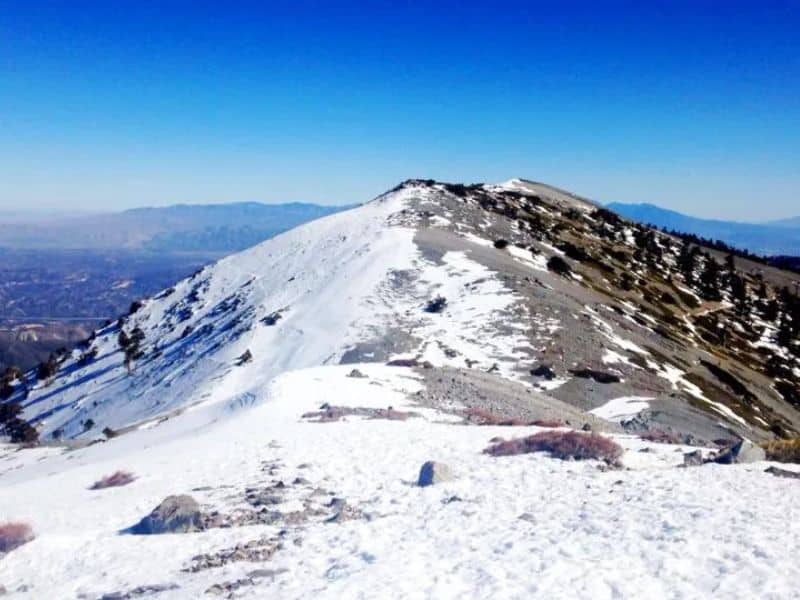
Their snow-white coats offer camouflage against the wintery backdrop. Bird enthusiasts might spot raptors riding the thermals or hear the distinctive calls of the hardy alpine birds.
Beyond the obvious hiking allure, Baldy Peak in winter appeals to mountaineers and backcountry skiers, drawn by its challenging terrain and unmatched downhill experiences.
Due to the rigorous conditions, it’s essential to be equipped with the appropriate gear, including crampons and poles, and to remain cautious of avalanche risks.
While Baldy Peak is typically hiked in a day, the broader Bridger Range offers numerous camping opportunities for those wishing to extend their adventure.
However, the challenging winter environment necessitates advanced preparations, and overnight campers should be equipped with gear to withstand the frigid temperatures.
Baldy Peak is not just a hike but a rite of passage for many outdoor enthusiasts. It demands respect, perseverance, and preparation, especially in the heart of winter.
However, for those who answer its call, the summit experience, with the world sprawling below, is an unmatched testament to the grandeur of Montana’s landscapes and the thrill of conquering nature’s challenges.
Blackmore Lake
Distance: 5 miles round trip
Difficulty: Moderate
Starting Point: Blackmore Trailhead
Distance from Bozeman: Approximately 20 miles to the south via S. 19th Ave and Hyalite Canyon Rd
Getting to the Trailhead: From Bozeman, take S. 19th Ave heading south. This will transition into Hyalite Canyon Rd. Continue driving until you see signs for Blackmore Trailhead.
Nestled within the expansive Gallatin Range, Blackmore Lake offers a serene winter escape, combining the calm of a frozen alpine lake with the awe of surrounding snowy peaks.
While the journey is moderately challenging, the lakeside tranquillity makes every step worth the effort.
The trail to Blackmore Lake takes you on a gradual climb through a blend of dense coniferous woods and open meadows. With each step, the quiet whispers of the forest and the crunch of snow beneath your feet accompany you.
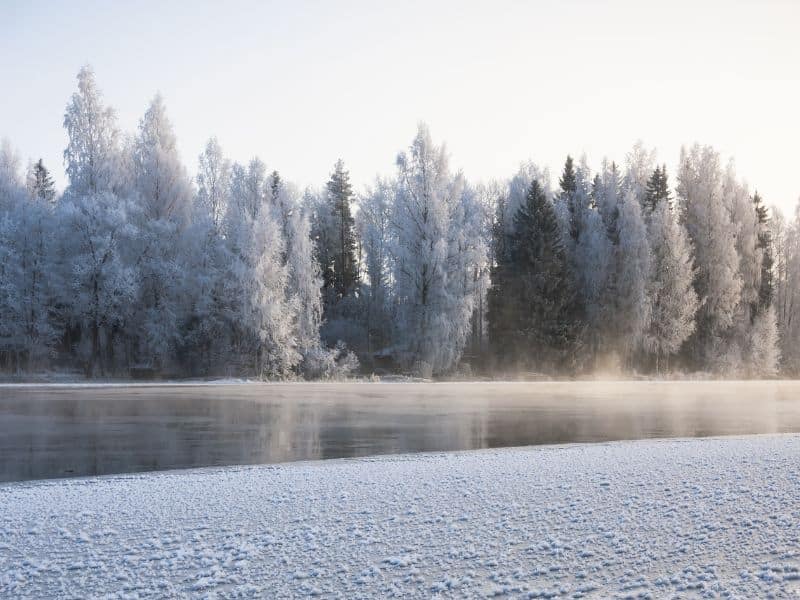
As you approach the lake, the trees give way to reveal a pristine snowy basin, with the water’s frozen surface reflecting the towering peaks around. It’s a place of profound calm, where the world feels still, and time seems to pause.
Despite winter’s chill, the area around Blackmore Lake teems with life. You might spot tracks of snowshoe hares or catch a glimpse of an elk herd grazing in distant meadows.
The woods can be a haven for birds, with species like the mountain chickadee or the pine grosbeak occasionally making an appearance, their songs echoing in the quietude.
Besides traditional hiking, Blackmore Lake is a magnet for snowshoers, drawn by the trail’s undulating terrain and the prospect of lakeside vistas.
Photographers, too, find inspiration here, with the lake offering countless compositions, from early morning mists to the golden glow of sunset against icy waters.
While Blackmore Lake can easily be explored in a day, those seeking a longer immersion into nature will find dispersed camping opportunities in the surrounding Gallatin National Forest.
As always, winter camping requires preparation, ensuring you’re geared for the temperatures and are following Leave No Trace principles.
Blackmore Lake is a testament to the hidden gems that Montana’s wilderness conceals, awaiting discovery.
Whether it’s the allure of a snowy landscape, the promise of solitude, or the simple joy of being amidst nature, this destination is a haven for the winter-bound soul, offering beauty, peace, and a touch of adventure.
Ousel Falls
Distance: 1.6 miles round trip
Difficulty: Easy
Starting Point: Ousel Falls Trailhead
Distance from Bozeman: Approximately 45 miles south, located near Big Sky
Getting to the Trailhead: From Bozeman, head south on US-191. Follow the highway towards Big Sky. Turn right onto Ousel Falls Road, and a short drive will lead you to the trailhead parking lot.
Ousel Falls, a gem tucked near Big Sky, offers an enchanting winter experience with a trail that’s accessible for most. Its relative shortness makes it an ideal outing for families, yet its beauty is such that even seasoned hikers find joy in its wintry splendor.
Meandering through a mix of dense woods and open spaces, the trail is a leisurely journey leading to the falls.
Winter blankets the surroundings in a silvery sheen, turning the path into a scene straight out of a storybook. Upon reaching the destination, the cascading Ousel Falls, often partially frozen in the colder months, presents a magnificent display.
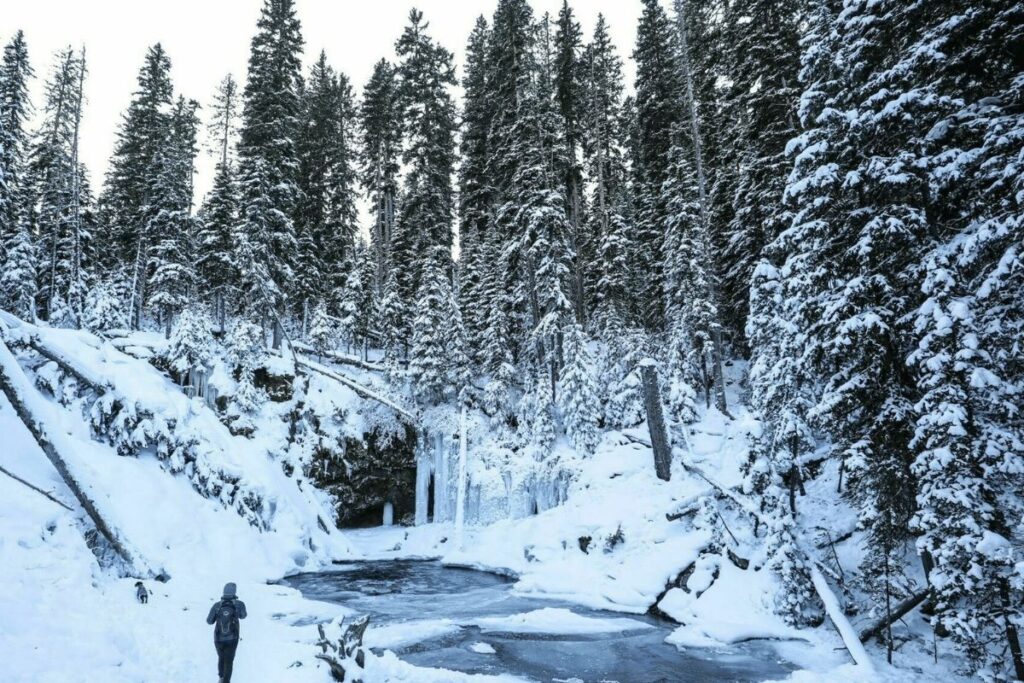
The roar of the water, combined with its icy aesthetics, paints a picture of nature’s dual force and elegance.
While the chill may deter many creatures, the area still whispers of wildlife. The observant hiker might spot squirrel tracks on fresh snow or hear the distant chirping of hardy winter birds.
The woods around the trail can sometimes also reveal signs of larger fauna, like deer or elk, that frequent the region.
Aside from the gentle hike, Ousel Falls in winter is a treat for photography enthusiasts. The combination of frozen cascades, snow-laden trees, and the subtle play of light offers a plethora of shots waiting to be captured.
Families with children often enjoy a playful snowball toss or the simple pleasure of tracing footsteps in fresh snow.
Owing to the trail’s brevity and its proximity to Big Sky, most visitors opt for a day trip to Ousel Falls.
However, for those wanting to camp, there are several campgrounds and more expansive trails in the broader Big Sky area, making it feasible to combine a visit to Ousel Falls with a more extended outdoor experience.
Ousel Falls is a celebration of nature’s winter palette.
It’s a place where the cold isn’t biting but invigorating, where the white expanses tell tales of quietude, and where the falls, in their icy grandeur, remind one of the persistent heartbeat of nature, even in its most tranquil moments.
For those near Big Sky or passing through, it’s a must-visit winter haven.
Sypes Canyon
Distance: 6.2 miles round trip
Difficulty: Moderate
Starting Point: Sypes Canyon Trailhead
Distance from Bozeman: Approximately 8 miles north via Springhill Rd and Sypes Canyon Rd
Getting to the Trailhead: From Bozeman, head north on N 7th Ave, turning right onto E Oak St, which will lead onto Springhill Rd. After a few miles, take a left onto Sypes Canyon Rd, following it straight to the trailhead.
Sypes Canyon Trail offers an exquisite winter journey, weaving through quintessential Montana landscapes.
The mix of gentle inclines and more challenging stretches makes it a fulfilling endeavor for those seeking a moderate hike with rewarding views.
The path begins by ushering hikers into a dense forest, where the trees stand tall, their branches heavy with snow.
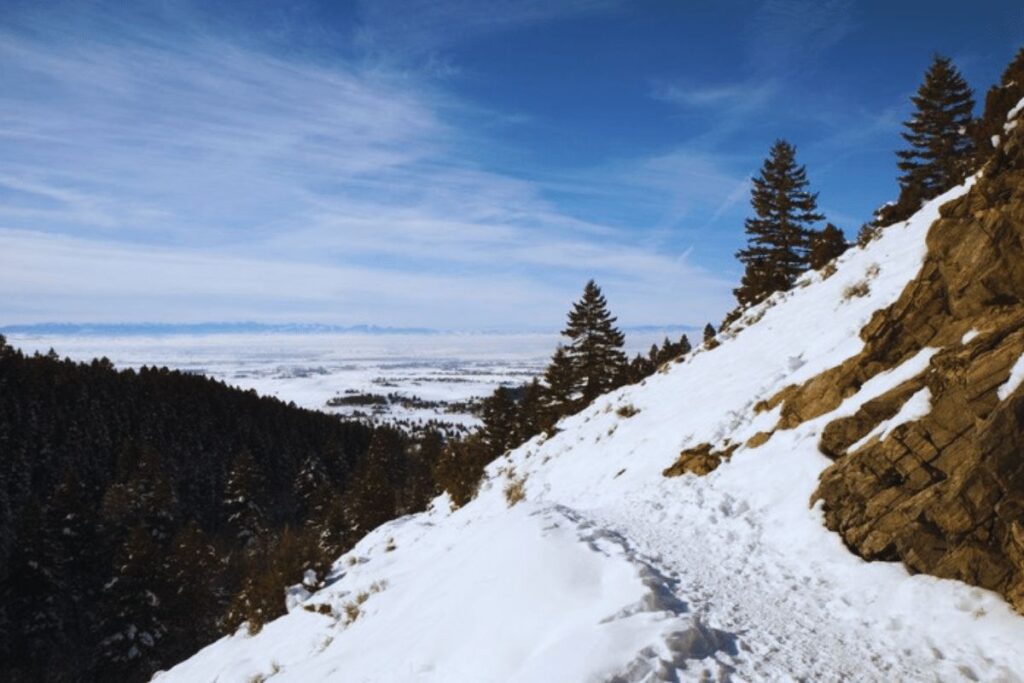
As you ascend, the trail unveils a series of clearings, each presenting expansive views of the Gallatin Valley below.
Reaching the trail’s culmination, a splendid overlook awaits, offering panoramic vistas of the Bridger Mountains and the distant Bozeman.
Amidst the winter serenity of Sypes Canyon, signs of wildlife are not uncommon. From the delicate tracks of foxes or the occasional deer to the overhead flight of a golden eagle, nature thrives here even in the colder months.
The cover of the forest may also hold surprises, like the soft hoot of an owl or the rustling of a marten.
While hiking is the primary draw, Sypes Canyon in winter attracts snowshoers, reveling in the pristine conditions. The varying terrains of the trail make it equally enticing for beginners and those more acquainted with snowshoeing.
Additionally, its viewpoints offer opportunities for landscape photography, especially in the early morning or late afternoon when the winter sun casts a golden hue over the valley.
Given its proximity to Bozeman and the trail’s moderate length, many choose to make Sypes Canyon a day trip.
However, the broader Bridger Mountain range and nearby national forests offer ample camping sites for those keen on extending their wilderness experience, though always be prepared for Montana’s crisp winter nights.
Sypes Canyon is more than just a trail; it’s an invitation into the heart of Montana’s wintry embrace. It’s where the silent footfalls on snowy paths echo stories of nature’s stillness and beauty.
Whether you seek a meditative walk, a challenging snowshoe session, or simply a moment to marvel at the landscape, Sypes Canyon welcomes with open arms, promising memories that linger long after the snow melts.
Garnet Mountain Trail
Distance: 7.7 miles round trip
Difficulty: Moderate to Strenuous
Starting Point: Garnet Mountain Trailhead
Distance from Bozeman: Approximately 28 miles south via US-191
Getting to the Trailhead: Starting from Bozeman, drive south on US-191. After passing Gallatin Gateway, you’ll find signs guiding you to the Garnet Mountain Trailhead.
Ascending one of Montana’s notable peaks, the Garnet Mountain Trail promises an adventure characterized by its diverse terrains and breathtaking panoramas.
A bit of a challenge, especially in winter, the hike is a testament to Montana’s rugged beauty, crowned by an unmatched summit view.
The journey commences with a gradual incline, meandering through verdant forests where snow-laden trees arch gracefully overhead. As you climb, the surroundings transition, presenting open spaces dotted with rock formations and wintry meadows.
Nearing the peak, the trail’s challenge intensifies, but it’s the summit that rewards tenfold: a 360-degree panorama of snow-capped peaks, sprawling valleys, and a horizon that seems to stretch into eternity.
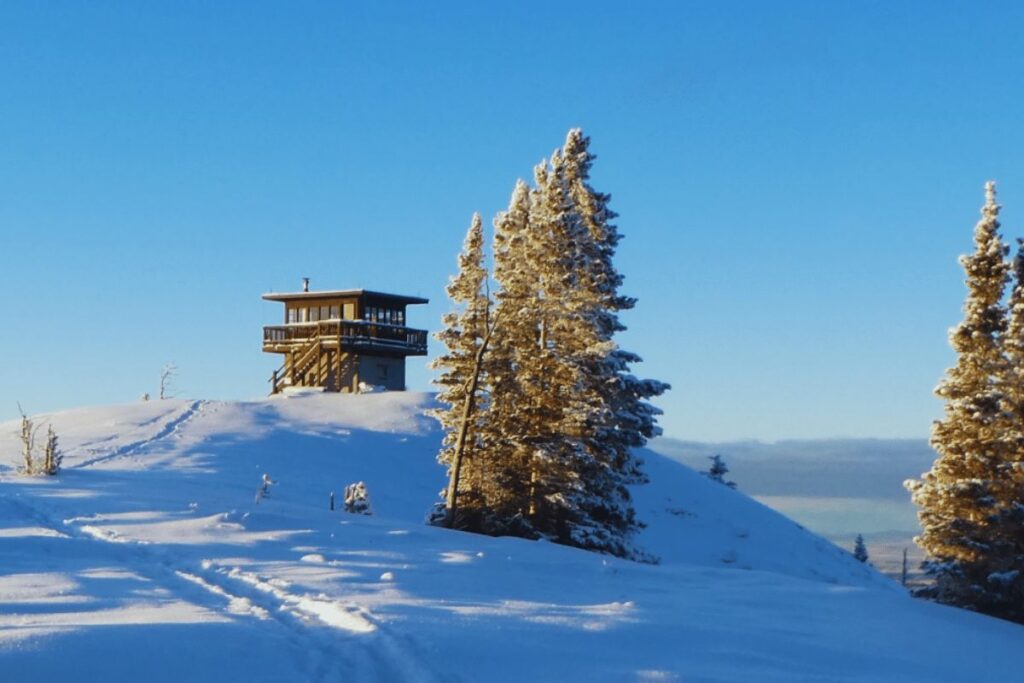
Winter transforms Garnet Mountain into a sanctuary of tranquility, but signs of wildlife persist. From the subtle imprints of snowshoe hare or the more pronounced tracks of a passing deer, life endures here.
Birdwatchers may be treated to sights of hardy mountain species, and there’s always the chance to witness the majestic flight of raptors.
Beyond traditional hiking, Garnet Mountain attracts winter sports enthusiasts. Snowshoers find the terrain both challenging and invigorating.
For the avid winter photographer, the sights along the trail and especially from the summit offer a dreamlike backdrop, perfect for capturing the essence of Montana’s winter.
While the trail’s length and intensity can be managed in a day, some adventurers choose to extend the experience.
The vicinity of Garnet Mountain offers dispersed camping opportunities. Remember, winter camping in Montana demands thorough preparation, with temperatures dropping significantly during nights.
Garnet Mountain Trail isn’t just a path in the snow; it’s a pilgrimage to one of winter’s most stunning altars. Every step, every breath of cold air, every gaze upon the expansive vistas reminds you of nature’s grandeur and the unique beauty Montana offers.
If you’re searching for a winter journey that challenges and rewards in equal measure, this trail beckons with promises of memories that’ll warm you for years to come.
Hummocks & Uplands
Distance: 5 miles round trip
Difficulty: Moderate
Starting Point: Hummocks Trailhead
Distance from Bozeman: Approximately 48 miles south, located near Big Sky
Getting to the Trailhead: From Bozeman, venture south on US-191 towards Big Sky. Look for signs pointing to the Hummocks Trailhead to begin your excursion.
The pairing of Hummocks and Uplands trails presents a balanced and enchanting winter hike. Together, they offer a delightful trek through a tapestry of terrains, all donned in a thick blanket of snow, making the experience uniquely Montana.
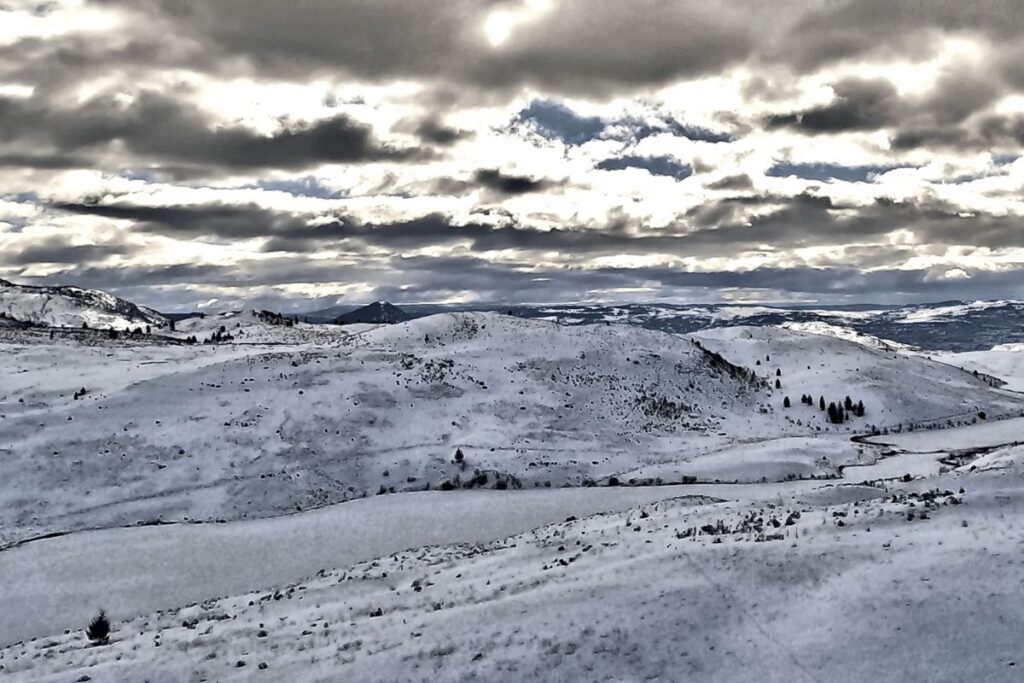
Starting with the Hummocks Trail, hikers are introduced to a gentle undulating path that dances through wetlands and over small hills, showcasing a myriad of micro-landscapes.
Transitioning to the Uplands segment, the route takes on a slightly more elevated profile, gracing adventurers with wider vistas of the surrounding mountains and valleys.
These trails, particularly the wetland areas of the Hummocks, serve as wintering grounds for various species. Signs of waterfowl, elusive otters, and even beavers might be discerned around frozen ponds.
Tracks of deer, elk, and perhaps a solitary moose can be spotted on fresh snow, painting a vivid picture of the life that persists amidst the cold.
Apart from hiking, the area is also popular among snowshoers, given the moderate distance and diverse sceneries.
The serene backdrop, combined with the sparkling snow, makes it an excellent spot for winter photography, capturing moments of untouched nature and delicate wildlife.
Considering its length and proximity to Big Sky, many prefer to make the Hummocks & Uplands a day adventure. But those desiring an extended stay will find numerous camping and lodging options in the Big Sky area, suitable for winter conditions and close to other recreational opportunities.
In a state adorned with so many hiking wonders, the combined beauty of Hummocks and Uplands stands out, especially in winter.
Offering a mix of serene wetlands, rolling terrains, and elevated views, it’s a journey that resonates deeply with what it means to be amidst Montana’s wintry wild.
Whether a seasoned hiker or a family looking for a memorable outing, this dual trail delivers an experience both profound and picturesque.
Moose Tracks
Distance: 6 miles round trip
Difficulty: Moderate
Starting Point: Moose Tracks Trailhead
Distance from Bozeman: Details vary depending on the specific location of Moose Tracks Trail in relation to Bozeman. For this generic representation, we’ll say it’s approximately 30 miles southwest.
Getting to the Trailhead: From Bozeman, drive southwest on a main route, following signs that guide adventurers to the Moose Tracks Trailhead.
Nestled amidst Montana’s vast and varied landscape, the Moose Tracks Trail offers a winter escapade marked by its name—giving hints to the wildlife encounters one might experience.
This moderately challenging hike provides a comprehensive taste of Montana’s snowy splendor.
As the trail unfolds, hikers tread through dense evergreen forests, their canopy weighed down by fresh snowfall. Periodic clearings reveal sweeping views of distant mountain ranges, their peaks shimmering in icy grandeur.
The terrain is a medley of gentle flats interspersed with occasional inclines, ensuring an engaging hike throughout.
True to its name, Moose Tracks might present hikers with evidence of these majestic creatures—their footprints, a nibbled branch, or if fortunate, a distant sighting of a moose itself.
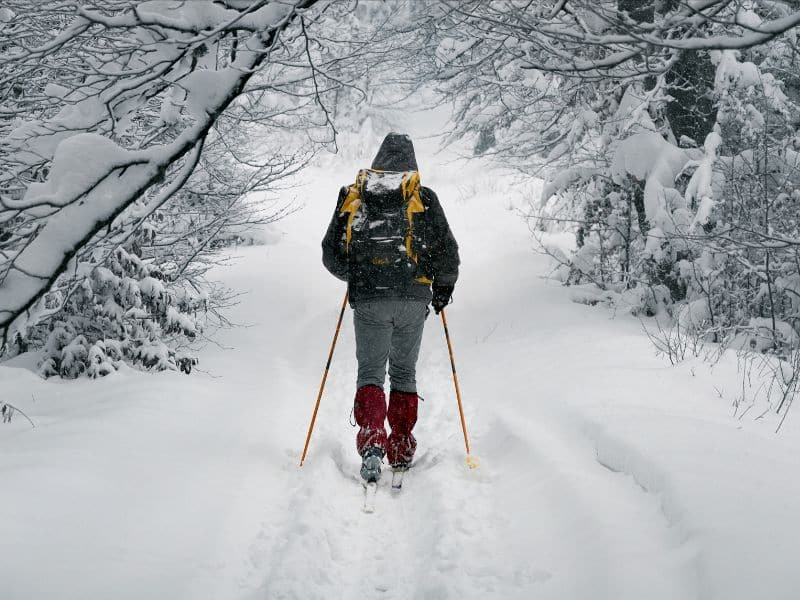
Beyond this, the silence of winter could be punctuated by the sights and sounds of other residents: frolicking squirrels, chirping winter birds, or the soft, fleeting footprints of a fox.
Beyond its appeal as a hiking destination, Moose Tracks is a favorite among snowshoers. The changing landscape, from wooded areas to open vistas, offers varied experiences for those traversing the snow.
The peaceful environment, coupled with the gentle snowfall, creates a dreamy setting for photographers and nature enthusiasts alike.
Given its moderate length, many choose to tackle Moose Tracks in a day. However, if one wishes to extend their stay, surrounding areas might offer dispersed camping or established campgrounds.
As always, winter camping in Montana requires preparation, ensuring warmth and safety in the chilly nights.
Moose Tracks isn’t just a hike—it’s a narrative of Montana’s winter realm, filled with tales whispered by the wind through pines and stories etched in the snow by wandering wildlife.
Every curve and corner of this trail invites hikers to delve deeper into this snowy sanctuary, leaving them with memories as pristine and enduring as the Montana wilderness itself.
Pine Creek Falls
Distance: 2.5 miles round trip
Difficulty: Easy
Starting Point: Pine Creek Trailhead
Distance from Bozeman: Approximately 40 miles south
Getting to the Trailhead: Begin your journey from Bozeman by heading south, following the direction signs which will eventually lead you to the Pine Creek Trailhead.
Pine Creek Falls is a winter hiker’s dream, offering a relatively short but visually rewarding hike.
While the falls are a spectacle in any season, winter bestows upon them an ethereal quality, turning the cascades into shimmering ice formations surrounded by a snow-draped landscape.
The trail starts with a gentle incline, winding its way through a canopy of pines. The soothing sounds of Pine Creek accompany hikers, hinting at the destination ahead.
As the falls come into view, one can’t help but marvel at the transformation winter brings – water turned to ice, cascading in a frozen dance, framed by snowy boughs and rocks.
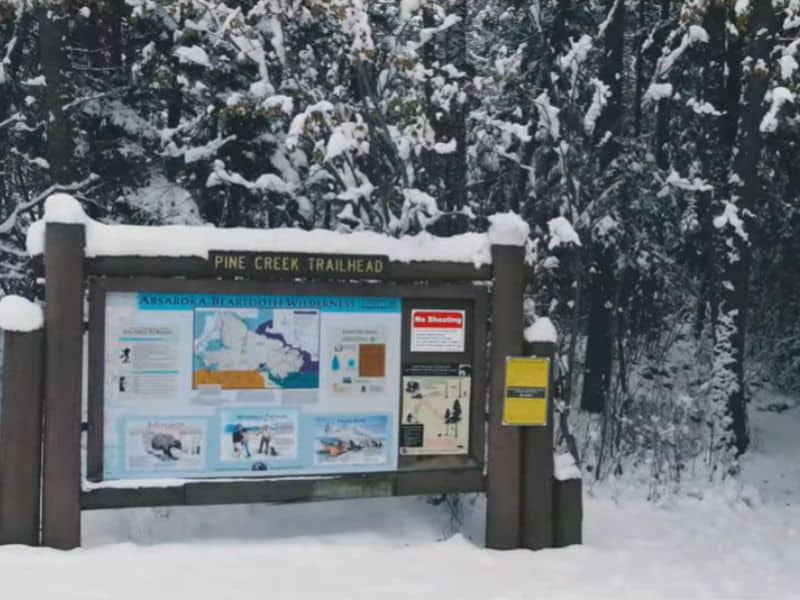
Despite its wintry cloak, the region around Pine Creek Falls is brimming with life. Birds flit between branches, while squirrels and other small mammals leave their tracks on the snowy trail.
With luck, one might even spot larger wildlife, like deer, delicately picking their way through the forest.
Aside from hiking, the Pine Creek Falls trail and its surroundings are a haven for photographers.
The contrasting visuals of dark pine against white snow, and the glistening frozen falls, create a scene straight out of a winter postcard.
Snowshoeing is also a popular choice given the trail’s manageable length and beautiful setting.
Though the trail is often completed in a few hours, for those wishing to linger in this winter wonderland, nearby areas might offer camping spots.
Always be prepared for the cold Montana nights and ensure that camping is allowed in the chosen area.
Pine Creek Falls trail offers a refreshing winter hike. It’s an experience marked by simple pleasures – the crunch of snow underfoot, the distant murmur of a frozen waterfall, and the sheer beauty of Montana’s winter woods.
Whether you’re a seasoned hiker or someone seeking a brief escape into nature, this trail promises a tranquil and memorable outing.
10 Safety Tips for Winter Hiking in Bozeman
Dress in Layers
In cold, fluctuating winter temperatures, dressing in layers is crucial.
Start with moisture-wicking base layers to keep sweat away, followed by insulating layers like fleece or down, and finally, a waterproof and windproof outer layer.
This system allows you to add or remove layers as needed to regulate body temperature.
Choose Proper Footwear
Invest in insulated, waterproof hiking boots with a good grip. These will keep your feet warm, dry, and prevent slipping on icy patches. Pair them with moisture-wicking socks to maintain comfort.
Check Weather and Trail Conditions
Before heading out, always check the local weather forecast and trail conditions.
Bozeman’s winter weather can change rapidly, so be prepared for varying conditions, and avoid hiking during storms or when avalanche risks are high.
Be Avalanche Aware
Some trails around Bozeman traverse avalanche-prone areas.
Educate yourself about the signs of avalanche danger, consider carrying avalanche safety equipment (like a beacon, shovel, and probe), and if possible, take an avalanche safety course.
Pack Essential Gear
Even if you’re planning a short hike, always pack essential winter gear. This includes a map, compass, headlamp, first-aid kit, extra food and water, and emergency shelter.
Stay Hydrated and Nourished
Cold weather can suppress thirst, but staying hydrated is vital. Carry a thermos with warm drinks to encourage regular sipping, and pack high-calorie, nutritious snacks to replenish energy.
Hike with a Buddy
There’s safety in numbers. Always hike with a partner or group in winter. If that’s not possible, ensure someone knows your route and expected return time.
Navigate with Care
Snow can obscure trail markers, making it easier to get lost. Carry a GPS, topographic map, and compass, and familiarize yourself with the trail route beforehand.
Know the Signs of Hypothermia and Frostbite
Understand the symptoms of cold-related illnesses. Hypothermia symptoms include shivering, fatigue, and confusion.
Frostbite often begins with numbness or tingling. If any signs appear, take immediate action: find shelter, change into dry clothes, consume warm food/drinks, and if necessary, seek medical attention.
Start Early and Time Wisely
Winter days are shorter, so start your hike early to maximize daylight. Always turn back with ample time to return before dusk, considering the pace might be slower on snow-covered trails.
24 Guided Hikes around Bozeman!
Conclusion
Bozeman is a great place to get outside and explore during the winter months. With so many options for hikes, it’s easy to find one that suits your level of fitness and interests. Whether you’re looking for a challenging hike with stunning views or an easy stroll through the woods, Bozeman has something for everyone.
So bundle up and head out on one of these eight favorite winter hikes around Bozeman!
We hope you enjoyed our list of favorite winter hikes around Bozeman Montana! If you’re looking for a great way to get outside and enjoy the beauty of the area, these hikes are definitely worth checking out. And, if you need any gear for your hike, be sure to stop by one of our local outdoor stores. They’ll have everything you need to make your hike a success!

